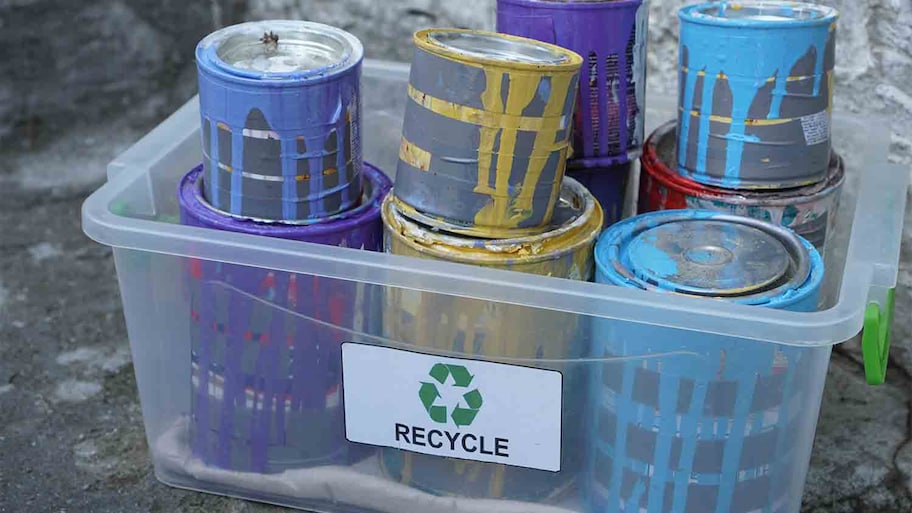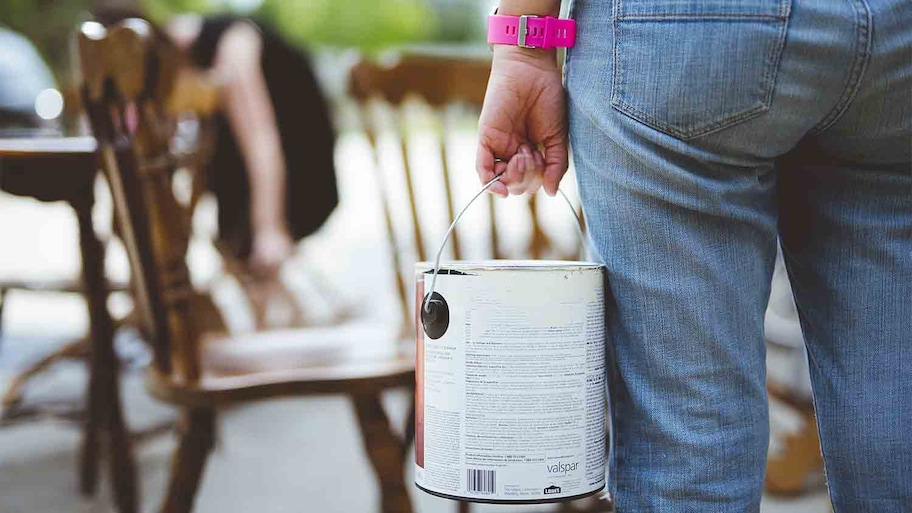Use these tips to clear out your stockpile of old paint cans once and for all
It’s not uncommon to have a spot in your home devoted to a pile of old paint cans. The painting projects may have ended a long time ago, but you were never totally sure how to dispose of the leftovers safely. We don’t blame you. Various materials—some considered hazardous waste—make up different paints, and it’s not always clear whether they belong in the same trash can that you usually use.
This guide will help you figure out what to do with old paint and empty paint cans, as well as how you can avoid creating paint waste in the first place.
1. Use Less Paint
Conserving the paint that you do use is one great way to ensure you never have to worry about throwing it in the garbage. Determining exactly how much paint you’ll need before beginning a project is one of the best ways to do this.
First, rely on paint swatches and small-sized sample jars to test the color before going all-in with a big can. That way, if you don’t like it, you don’t have to worry about tossing an entire can of paint. Then, measure the size of whatever it is you’re painting—whether that’s walls or a piece of restored furniture. Bring your measurements to a home improvement store and ask the designated paint professional for their expert assessment. They’ll tell you exactly how much paint you need to achieve your desired outcome.
2. Seal Paint Cans Tightly for Reuse
Having a bit of leftover paint is always helpful for future touch-ups—especially if the manufacturer discontinued the color. When sealed and stored correctly, paint can last for up to 10 or 15 years.
To seal a paint can properly, use a flathead screwdriver to remove as much residual paint as possible from the grooves and wipe up the debris with a cloth. Set the lid on the opening, and then use a rubber mallet or hammer to lock it in place.
Move all the way around the lid in a clockwise motion until you’ve touched every spot. Finally, store it in a cool, dark place (like a basement or closet) to ensure it lasts as long as possible. Just be sure to keep it away from any extreme temperatures; some paints are flammable.
3. Donate What You Can’t Use
Before heading to a donation center, ask around to find out if anyone in your circle needs a bit of paint. If you don’t have any takers, scope out your area for any community centers or other associations that would be happy to accept it. You never know until you ask. Even your local coffee shop might be able to make use of it!
4. Look for Paint Take-Back Programs in Your Area
Some states offer paint take-back and recycling programs to help you dispose of your paint in an environmentally-friendly way. Organizations like PaintCare provide drop-off centers throughout California, Colorado, Connecticut, Maine, Minnesota, New York, Oregon, Rhode Island, Washington state, Washington, D.C., and Vermont. If you live outside of these states, ask your local recycling facility about the best place to dispose of paint near you.
5. Know How to Dispose of Different Paint Types

Oil and latex are the two most common types of paint used for home improvement projects. And both need to be disposed of in different ways.
Oil Paint
Oil-based paints aren’t easy to dispose of because they’re highly flammable and their fumes potentially harmful. But that doesn’t mean getting rid of them is impossible—it’ll just take a bit more of your time.
Because oil paint is considered hazardous waste, recycling large amounts is obligatory. If you have a lot to get rid of, look for household hazardous waste collection locations in your area.
If you’re only dealing with a small amount of leftover oil paint, leave it out to dry in a well-ventilated area and away from any heat sources until it’s no longer wet to the touch. This could take anywhere from days to months, but you can speed up this process by adding an absorbent like kitty litter or sawdust. You can throw it away when it’s completely hardened.
Alternatively, paint the rest of your can onto scrap wood and throw the pieces in the garbage or leave them on the curb when they’re completely dry. Once again, be sure to let these items dry in a space with plenty of ventilation.
Latex Paint
Leftover latex paint is much easier to deal with because it’s water-based and therefore not hazardous. However, it must solidify before you can put it in the garbage.
Luckily, solidifying latex typically takes less time than solidifying oil paint. A small amount at the bottom of a can hardens just days after air-drying. But you can shorten the process to as little as a day by mixing it with a paint hardener like kitty litter.
6. Understand What to Do With Old Paint Cans
Now that you’re rid of the paint, it’s time to figure out what to do with those empty cans. First, find out if the recycling center in your area will accept them. In most cases, they’ll accept empty latex paint cans but maybe not hazardous oil paint cans. In these cases, your only option will be to deposit them at your local household hazardous waste collection facility. If you aren’t sure if your paint can is dangerous or not, stay on the safe side and assume that it is.
No paint collection facilities near you? There are plenty of creative ways to repurpose old paint cans, from turning them into garden pots to outdoor lanterns.





